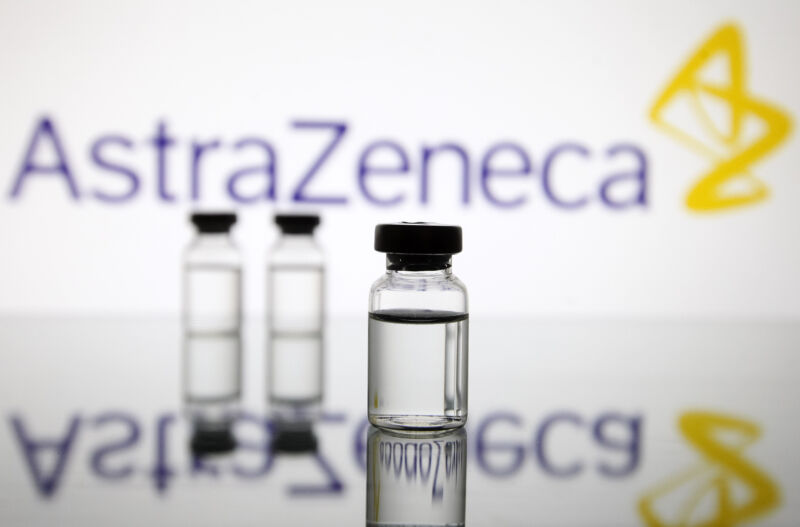
Pharmaceutical giant AstraZeneca and the University of Oxford made an exciting announcement Monday: the COVID-19 vaccine they developed together appeared up to 90 percent effective at preventing disease. But in the days since, that exciting news melted into a pool of confusion after it became clear that the 90 percent figure came about from a complete accident. Now, experts are scratching their heads over what actually happened in the trial and what it means for the vaccine’s future.
The questions all swirl around the vaccine’s dosage regimen. In initial press releases, AstraZeneca and Oxford explained that researchers had used two different dosage regimens to test their experimental vaccine, AZD1222. In one regimen, trial participants received two “full” vaccine doses, 28 days apart. In the other, participants received a half dose of vaccine followed by a full dose 28 days later.
Pooling results from trials in the United Kingdom and another in Brazil, the researchers found the two-full-dose regimen was 62 percent effective at preventing COVID-19—a good, but not great result. The half-dose/full-dose regimen, on the other hand, appeared 90 percent effective—a rather impressive result.
The trouble is, there was never supposed to be a half-dose-full-dose regimen in any of the trials.
Serendipity?
“The reason we had the half-dose is serendipity,” Mene Pangalos, AstraZeneca’s head of non-oncology research and development, told Reuters in an interview Monday.
Pangalos explained that when the UK trial first began, Oxford researchers were giving patients their first round of shots and noticed that the vaccine’s side-effects—fatigue, headache, arm aches—were milder than expected.
“So, we went back and checked ... and we found out that they had underpredicted the dose of the vaccine by half,” Pangalos said. The researchers then decided to continue on with the trial and give the relatively small number of incorrectly dosed patients the proper dose for their second shot.
In the pooled trial analysis, 2,741 participants were recruited while the incorrect half-dose/full-dose regimen was used and 8,895 participants were involved in the analysis of the two-full-dose regimen.
AstraZeneca and Oxford have been mum about how that error occurred exactly. Meanwhile, outside experts have raised doubt about whether the 90 percent efficacy with the half-dose/full-dose is even real, given the smaller number of participants.
Another wrinkle is that the dosing error occurred early in the trial when researchers were only recruiting people between the ages of 18 and 55—excluding older people more vulnerable to disease. The analysis with the two-full doses, on the other hand, did include older age groups.
Lingering questions
“There are a number of variables that we need to understand and what has been the role of each one of them in achieving the difference in efficacy,” Moncef Slaoui, chief scientist of the US government’s Operation Warp Speed, said in a press briefing Tuesday.
Operation Warp Speed has invested in AZD1222 and is supporting an ongoing trial of the vaccine in the US. Slaoui noted in the press conference that they knew about the dosing error at the time it happened. “When they realized that there was an error—or a change in the approach, the technique used—they corrected it,” he said.
Now that the results have come out, Slaoui says it’s important to dig into what was going on between the two regimens. For one thing, researchers should look to see if there are different immune responses induced by the different dosages schemes. Some researchers have speculated that ramping up the vaccine dosage between the first and second shot could have helped build up better immune responses against the pandemic coronavirus, SARS-CoV-2.
Others have speculated that starting with a strong dose—as in the two-full-dose regimen— may have foiled efficacy because of the way AZD1222 is designed. The vaccine uses a weakened adenovirus as packaging to deliver to the immune system the genetic code for the SARS-CoV-2 spike protein. But starting out with a strong first dose may prime the immune system to focus on attacking the adenovirus, rather than the packaged coronavirus component, some think.
Once researchers have a better understanding of what was going on, then they can make decisions about altering the ongoing trials, Slaoui said. In the US, about 11,000 of a planned 40,000 participants have been recruited for a Phase III trial of AZD1222. So, it could still be altered to include the half-dose regimen if new information comes in. However, Salaoui noted that such information would have to come quickly, given the rate the pandemic is progressing in the US.
On a final note, Slaoui reemphasized that the difference in efficacy and the dosage error as whole could be meaningless in the end: “The 90 percent efficacy group and the 62 percent efficacy group are overlapping statistically, so it is still possible that that difference is a random difference,” he said. “It’s unlikely but it’s still possible it’s a random difference.”
Health - Latest - Google News
November 26, 2020 at 05:15AM
https://ift.tt/377kpM8
AstraZeneca’s best COVID vaccine result was a fluke. Experts have questions - Ars Technica
Health - Latest - Google News
https://ift.tt/2zrj9Ud
Bagikan Berita Ini














0 Response to "AstraZeneca’s best COVID vaccine result was a fluke. Experts have questions - Ars Technica"
Post a Comment